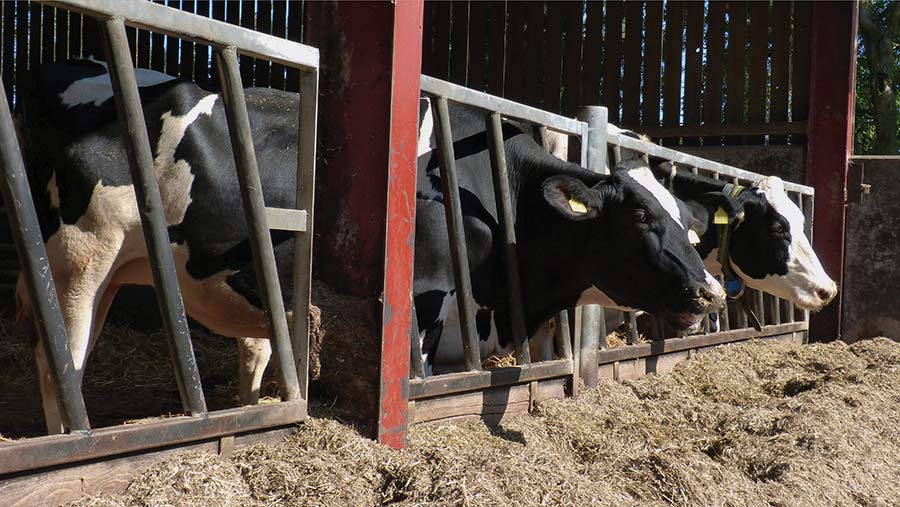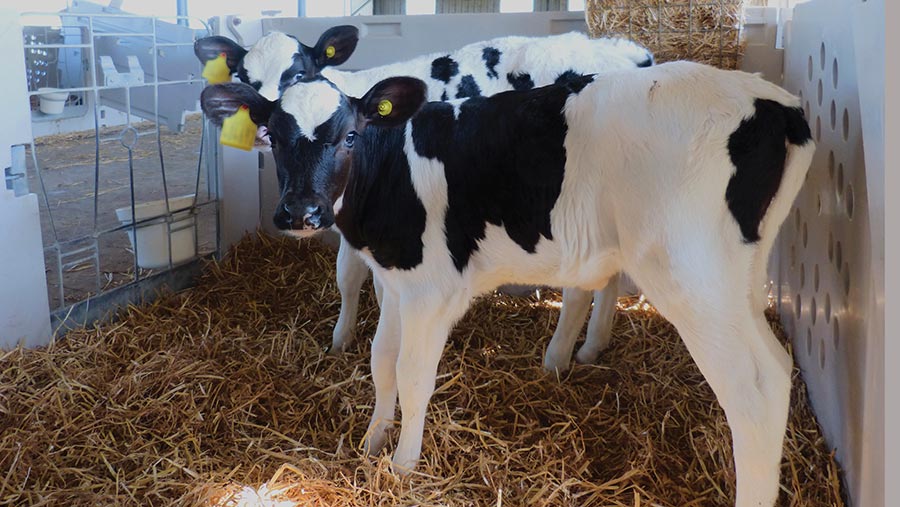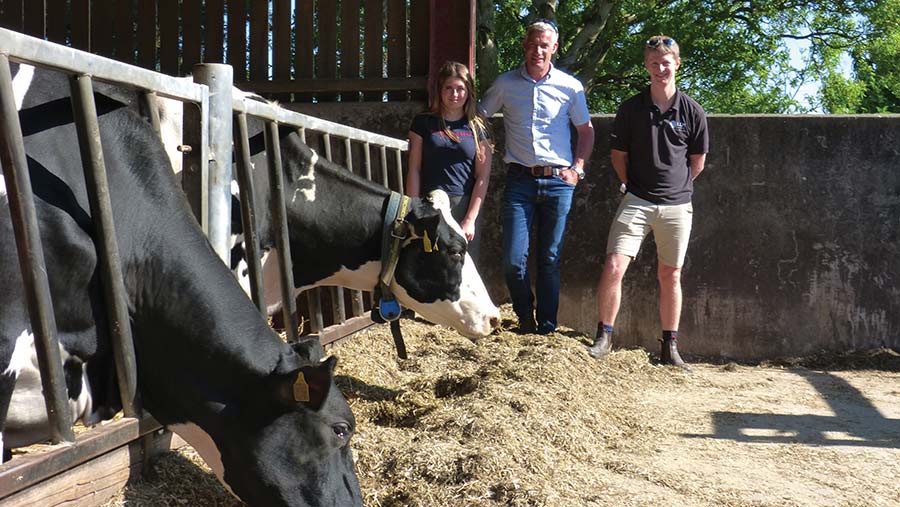4 ways a high-output dairy farm cut vet costs to 0.72p/litre
 Dry cows at Norbreck © MAG/Michael Priestley
Dry cows at Norbreck © MAG/Michael Priestley A data-driven approach to herd health has seen a high-output dairy cut its vet and medicine cost in the past six years by nearly 0.5p/litre to 0.72p/litre.
Phil Halhead, of Norbreck Farm, Cockerham, near Lancaster, currently pays £87 a cow for all drugs, herd health scheme work, consultancy, and vet time (see table below).
He identifies four ways vet and medicine costs are controlled.
See also: How a 540-cow dairy benefited from recycled bedding
Farm facts: Norbreck Farm, Cockerham, Lancashire
- 100ha (250 acres) of grassland
- 290 Holstein milking cows
- All-year-round calving and fully housed
- Average milk production 12,600 litres
- 4.14% butterfat and 3.16% protein
- Somatic cell count 149,000/ml
- Supplying Tesco direct through Arla
- 1,000t of maize silage bought in
- Three-times-a day-milking
1. Open discussions
Good vet relations are key to addressing issues and getting the most out of the herd health monitoring systems on the farm, explains Phil. The farm’s regular consultant is Alun Beckett of LLM Farm Vets.
The team meets with the vets every few months for one to one-and-a-half hours.
More detailed quarterly reports are produced using Kingshay/Vet Partners benchmarking tools covering mastitis, fertility performance and calf growth rates along with an annual review as part of the herd health plan.
The LLM Farm Vets health reports are often influenced by wider discussions with the farm’s independent nutritionist, Hefin Richards of Rumenation.
“Constantly reviewing figures and proactively addressing problems when they show up is far better than just getting in touch with the vet to fight fires,” says Phil.
Reduction in vet costs at Norbreck, 2017-2023 |
||
|
Year |
p/litre |
Cost/cow |
|
2017 |
1.21 |
£113.30 |
|
2020 |
0.84 |
£92.61 |
|
2021 |
0.77 |
£81.69 |
|
2022 |
0.75 |
£78.15 |
|
2023 (to June) |
0.72 |
£87.89 |
2. Use of data
Many of the farm’s management decisions are driven by data, including one recent intervention in youngstock management.
The youngstock system weans calves at 100kg, grows them to about 200kg at about five months old, then takes them to a contract-rearing farm to grow, get in calf and return a month prior to calving.
Calves are weighed every few weeks and growth rates are logged in the LLM database. Last spring, a 40% drop in daily liveweight gain (DLWG) of calves, from 1kg to 0.6kg, was picked up.
On closer inspection, the problem was found to be worse in heifer calves out of heifers. LLM vets suggested taking blood samples from the in-calf heifers at the contract-rearing farm.
These tested low for iodine, resulting in newborn calves lacking vigour. The deficiency was corrected with a pour-on and a bolus.
The vets also noticed a spike in calf mortality, from 0.7% to 4.4%, in the calves under 24 hours old.
This was found to be linked to the use of short-gestation bulls, resulting in calving five to seven days earlier than standard gestation length.
As a result, the vaccine used to boost the colostral antibodies for rotavirus and coronavirus were not coming into effect.
Surviving calves were not as vigorous and were being challenged by pathogens because the antibodies in the colostrum were not sufficient.
The colostrum booster vaccination is now given two weeks earlier, and iodine is supplemented as standard. Calf DLWGs recovered to 0.85-0.9kg through the autumn.
Other examples of herd data informing management changes include:
- Fans in cubicle shed to address heat stress and stale air
- Investing in accurate rationing through a Keenan diet feeder
- Collars for heat detection and rumination.
The alterations have enabled the business to get good performance out of buildings that are 50-60 years old, explains Phil.
3. Genetic progress
Another key factor in managing medicine cost is the genetic merit of the herd. A focus on health and robustness has helped create a cow with fewer issues, he says.
Genetic progress has developed in the following ways:
- Genomics Genomic testing and selection has been taking place at Norbreck for 13 years to select for health traits. This means the team has more information when making selections about which cows to flush and breed to sexed semen.
- Balanced breeding Profitable lifetime index and health and fertility traits are used to select bulls, rather than selecting on yield. This is to breed cows with fewer health issues during their productive life.
- Cow type The team’s aim is to breed a thicker, deeper, more robust cow, rather than focusing on yield. They are currently selecting against short teats and very straight legs. Most mature cows weigh 725-750kg, but this is being brought down to nearer 700kg.
- Udders Udder conformation has improved hugely in the herd, helping control mastitis. Cases stands at 6.1%.
- Longevity Average age at culling has increased from 62 to 66 months over the past couple of years, meaning the herd, which calves at 24 months, is averaging more than three lactations.
4. Calf housing
A high-specification calf shed built to University of Wisconsin design recommendations is helping minimise calf health issues. In line with Tesco’s contract, calves are reared in pairs.
- Flooring Two lines of pens are set on a sloping concrete floor so bedding straw is kept clean and dry for longer and urine flows into a slot drain in the central passage. Sawdust bedding is used in summer and straw in winter when temperatures are below 10C.
- Climate control Temperature, wind speed and direction are measured electronically. Ventilation curtains are lifted and lowered automatically as needed, minimising wind chill and maximising fresh air. Clean air is kept moving through the shed by a wind tunnel along the roof.
- Biosecurity No equipment leaves or enters the shed. All equipment in the shed is solely for calves.
- Hygiene Pens are cleaned with a chlorocresol-based disinfectant to combat coccidiosis and cryptosporidium.
- Consistent milk feeding A calf kitchen with an automatic milk mixing machine delivers consistent milk to calves. Buckets are washed and dried on a rack.
- Results Pneumonia cases are very low at 1.1%, and mortality in the first 24 hours has returned to 0.7%.

Norbreck calves © MAG/Michael Priestley
Staff management at Norbreck

Phil Halhead, centre, with herdsperson Charlotte Walling and Alun Beckett of LLM Farm Vets © MAG/Michael Priestley
Phil Halhead spends most of his time running beef genetics company Norbreck Genetics, so he depends on a hard-working and diligent farm team to get results.
“In a typical week, I do not do any farming,” he explains. “The team is entrusted to stick to protocols.”
Staff are split into day and night teams, which are kept as separate as possible to avoid burnout:
- Day team Four full-time staff work 5am-4.30pm four days a week
- Night milkers A larger team of eight work on rotas, each doing a three-hour milking and calving pen check.
Day team members are regularly involved in meetings so they can contribute to management and have their opinions heard. They have an annual performance review to set goals and address issues.
They are trained in foot trimming and artificial insemination and encouraged to go on courses and industry events to broaden their horizons.
Phil says: “Broadly speaking, we need three things to align for a good member of staff being happy here long term: talent, application, and attitude.”
Herd manager Nick Haigh has been at Norbreck for 19 years and herdsperson Charlotte Walling has completed seven years.
